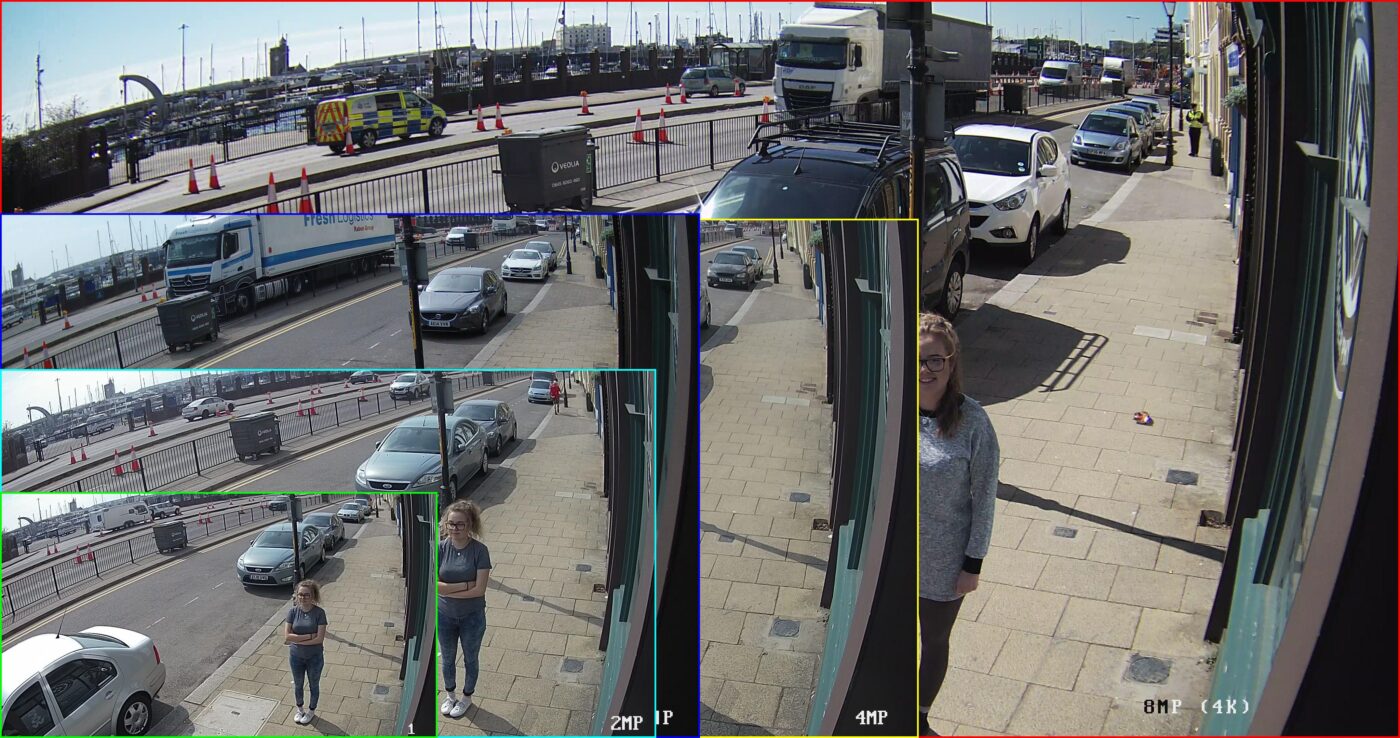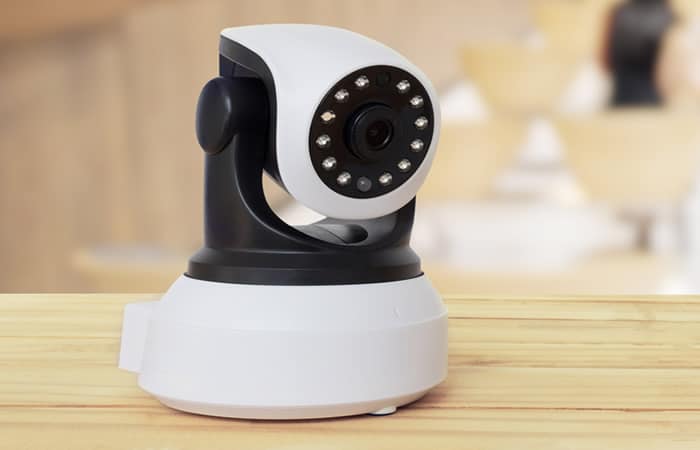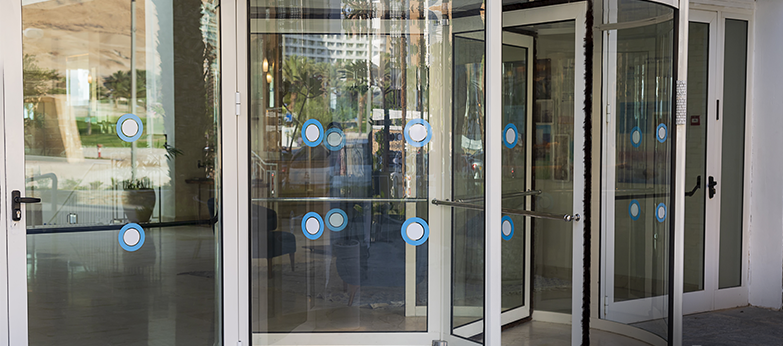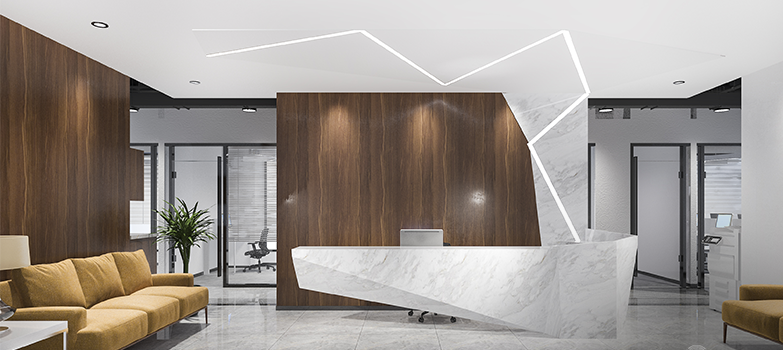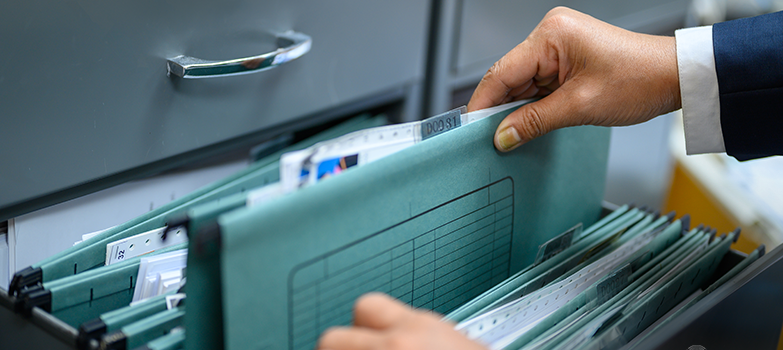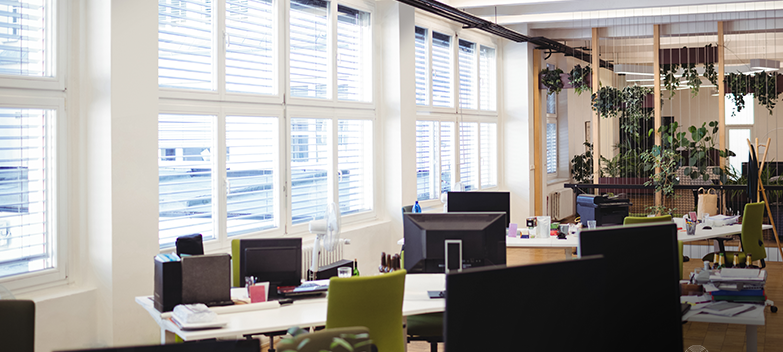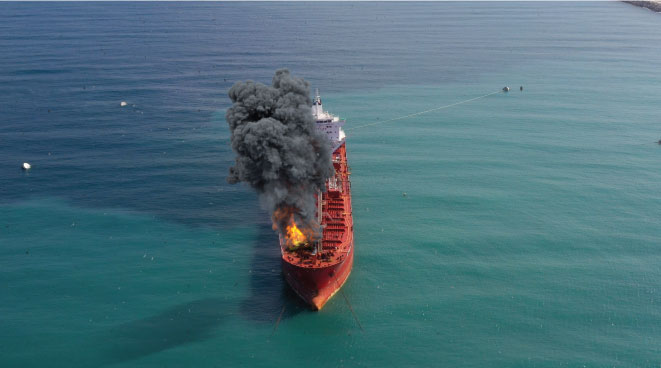MUST KNOW
WHAT IS THE BEST HOME CCTV SYSTEM?
Things To Consider While Hiring A CCTV Camera Dealer
5 Major Advantages of Placing CCTV Cameras in Public Places
IMPORTANCE OF CCTV CAMERAS IN SCHOOLS
WHAT ARE THE DIFFERENCES AMONG CCTV DOME, BULLET AND TURRET CAMERAS?
HOW TO CHOOSE THE RIGHT SECURITY CAMERAS FOR YOUR HOME
THE USE OF CCTV CAMERAS ON SHIP
IMPORTANCE OF CCTV CAMERAS IN SCHOOLS
Differences in Camera Resolutions
Which Are Safer? IP vs DVR Security Camera Systems
A Guide To Placing CCTV Cameras In The Office
MARITIME ( 24/7 Superb images for safety and security in maritime )
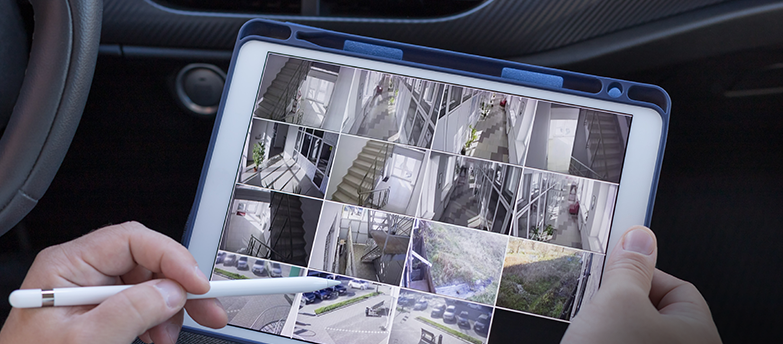
CCTV cameras are used by enterprises to protect their businesses and workers. Every Singapore company has a CCTV system.
Getting a good security system is merely the first step in building a safe work environment. As a company owner, you must know where to put cameras. When a crime happens, you need clear film to identify the culprit.
Don’t worry if you don’t know where to place CCTV cameras. Our team has ideas. Find out where to put your cameras to maximize the efficacy of your CCTV system.
Corporate espionage and theft are typical corporate threats. If you place expensive equipment like computers and tablets or secret papers in an asset room, you must install CCTV.
Installing cameras eliminates blind spots. Multiple cameras in places where you keep company assets, office supplies, and private papers may show internal theft or corporate eavesdropping.
During lunch or after work, employees often leave their work devices or important papers unattended. Others may take essential information or equipment. Install CCTV cameras in the workplace to avoid internal theft.
Before installing CCTV, you must tell your staff whether they will be watched. This lets you explain your choice and hear employees’ concerns.
Installing a CCTV camera in the workplace might ease their privacy worries. The camera can record much of the workplace without invading employees’ privacy. When a CCTV system is placed in the workplace, workers are less inclined to slack off. Business owners must know where to install CCTV cameras. Our instructions will help you protect your workplace and workers. Your camera positioning isn’t enough. Your workplace needs a trustworthy surveillance system with strong security features. Ensure you choose the right CCTV system for your company. IRoyal Security can help you choose the perfect security system for your company. We’ll help with all aspects of workplace surveillance. Contact us now for a consultation.
HIKVISION'S NEW "STORAGE SAVER" H.265+ ENCODING TECHNOLOGY

Over the previous decade, surveillance manufacturers created MJPEG to H.265 encoders. Higher resolution with less bandwidth is the goal. Hikvision has raised the bar with its new H.265+ encoder, while other firms struggle to switch to H.265.
Differences between H.264, H.265 and H.265+.
For simplicity’s sake, let’s avoid technicalities. Reduced bitrate (the number of bits that are transferred or processed per unit of time.) lower bandwidth (measured in bits per second).
How?
H.265+ employs a steady backdrop image to concentrate on moving objects. When a moving item disrupts surveillance, H265+ utilizes it as a reference frame. The system only adds data for moving objects.

Conclusion
Hikvision introduces an unmatched H.265+ encoder. H.265+ utilizes H.265/HEVC encoders with the same resolution but less bandwidth and storage. . It expands ultra HD video’s use in 8MP and 12MP surveillance equipment. It will minimize storage costs and boost ultra-HD video appeal.
HOW DO IP CAMERAS GET POWER?
IP camera systems may power each camera in two ways, unlike previous versions. PoE reduces wire space and simplifies installation. Switches with Cat5e or Cat6 network cables enable the feature. If no switch is provided, a 6 or 12 volt AC adaptor is used to power an IP camera. Whether you use a cable or a wireless connection, security cameras need less wiring.
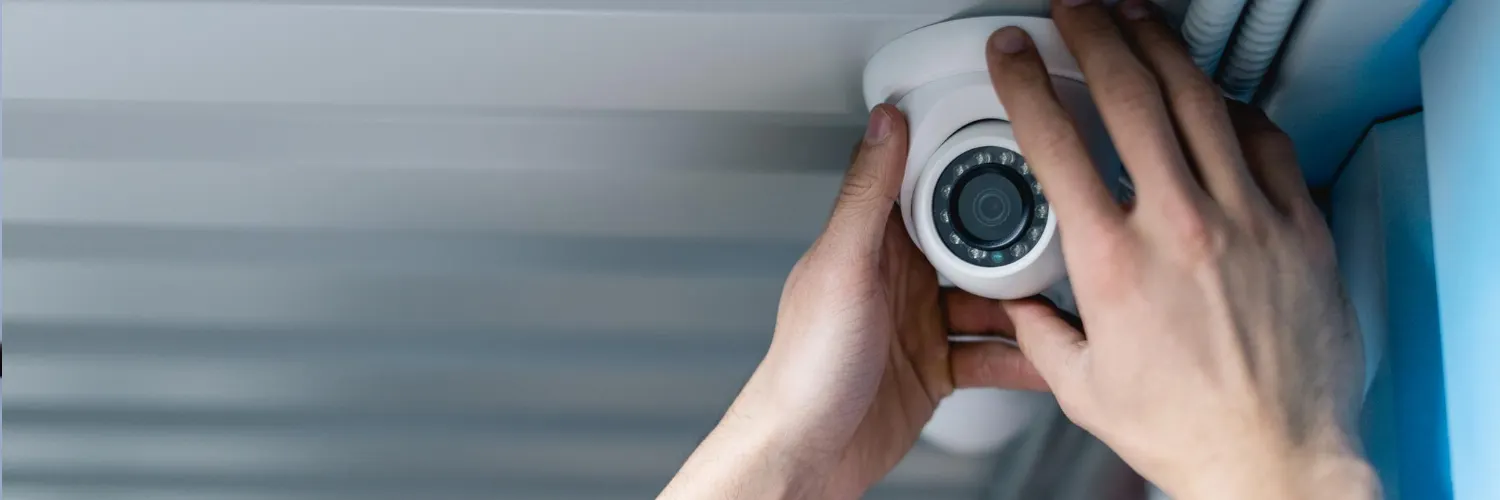
CAN I CONNECT AN IP CAMERA DIRECTLY TO A PC?
Modern security cameras may all be linked to a PC. There are several ways to configure IP cameras. Assuming your devices are powered, the first approach is a direct ethernet or network cable connection.
With one to three IP cameras, just ethernet wires are needed. To record, stream, manage, and more on-site, special software must be installed. Basic software is free from manufacturers or reputable resellers. IRoyal Security Cameras offers superior choices for homes and businesses.
The second technique is identical to the first, but adds a bigger hard drive and switch for a more sophisticated IP security system. More cameras attached to the computer need higher-tier software to control each device and give greater processing.
Using a PC in an IP camera system removes any other capabilities except managing IP surveillance cameras and collected data. While not always true, most security PCs are designed to be dedicated.
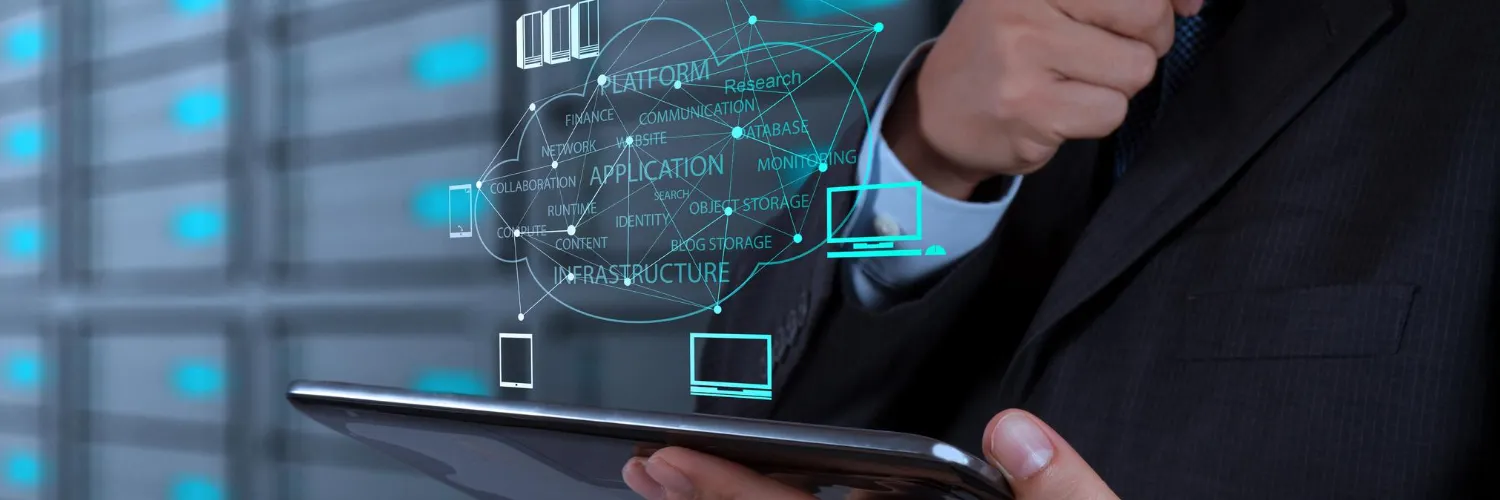
CAN IP CAMERAS WORK WITHOUT INTERNET?
Yes, but hard-wired, not wifi. Directly wired security cameras will continue to transmit and save video to the NVR or connected PC. Without internet, an IP camera system can’t be remotely seen or stored in the cloud. Security Cameras recommends a wired connection over wifi. As noted in a previous piece regarding Ring cameras, wireless cameras have many vulnerabilities that may compromise a security camera system. Later, we’ll explain how the typical IP camera setup adds security. IP cameras may capture video internally while wireless, but for a short period.
CAN IP CAMERAS BE HACKED?
Yes, IP cameras can be hacked. Like other advanced devices, there are ways to prevent or stop hacking. The federal Wiretap Act makes hacking unlawful in the U.S. by combining deliberately gaining unauthorized access to equipment with physically interfering to get particular information or access. Hackers or malevolent parties may use:
-Ascertaining the IP address to a device or IP camera system
-Physically tampering with a machine to find model information
-Physically adding malicious hardware to a device
-Phishing or scamming for access to the security system
-Dishonestly gaining access to the physical system
-Creation and distribution of malware
-Password cracking
As demonstrated in this and the prior jammer piece, hacking is more complex than other crimes and may be as easy as an email or as complicated as a months-to-years-long procedure. Good news is that home hacking is rare and can be stopped with simple steps. Home or business owners may protect their IP camera system from hackers by:
-Password protection
-Use Dynamic IP address
-Keep everything updated
-Practice discipline with email
-Directly wiring each IP camera
-Never download unvetted software
-Limit access to the IP camera system
-Secure surveillance camera placement
Using all of these options may not be possible, but they will help protect an IP camera system from attackers. Employing common sense with electrical gadgets might help secure your security system. Password protection, upgrading each gadget quickly, adopting online discipline, and restricting access to your security gear are free, personal measures. Directly connecting each camera to a local network reduces hacking risk.
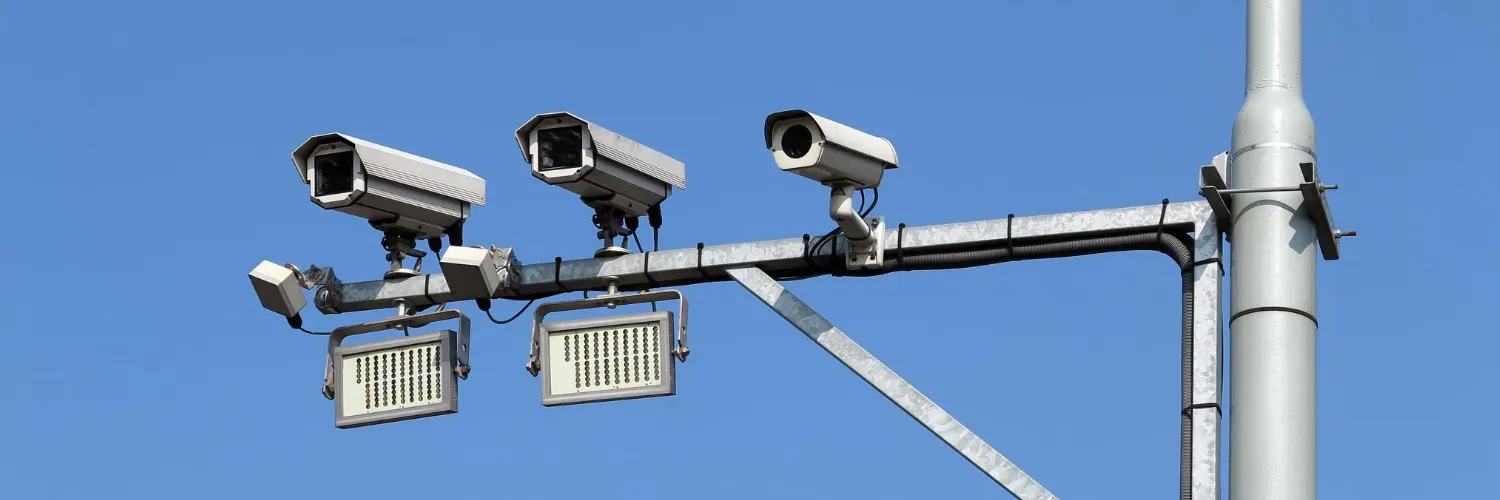
ARE IP CAMERAS SAFE?
IP camera systems are safe for households and businesses notwithstanding the aforementioned. A constantly updated gadget with passwords has robust wireless security, like other high-functioning internet-connected devices. Personalizing the systems’ default cybersecurity measures improves them greatly. Finally, security cameras directly attached to the local network are safer and more secure.
Physically, each IP camera system meets legal and industry requirements. Standard examples:
-IEEE (Institute of Electrical and Electronics Engineers)
-ONVIF (Open Network Video Interface Forum)
-SNMP (Simple Network Management Protocol)
Manufacturers worldwide follow these criteria and more to create safe goods. IRoyal Security Cameras can provide more manufacturing certifications and methods. Our specialists are available to help you choose an IP camera system.

WHAT CCTV MEANS?
CCT stands for closed-circuit television. CCTV refers to security systems that employ analog cameras and recordings. Contrary to wireless cameras, they need wiring. This security camera system transmits video data through coaxial lines to a DVR for processing, storage, and viewing. In recent years, CCTV has grown to incorporate digital systems like IP cameras. As indicated, wired IP systems fit within this criterion.
WHAT ARE THE SEVEN COMPONENTS OF CCTV?
Depending on who you ask, a security camera system has a few or many parts. IRoyal Security Cameras’ seven CCTV components are:
-A recording device (NVR or DVR)
-Wired security cameras
-Wiring
-Mounts for each device
-Transformers or a connection to a power supply
-Monitors
-Switches for channels
Unlike a security camera system, a CCTV system needs surveillance equipment to be linked to a local system. Closed-network TV doesn’t have to be analog or digital; it may be wired. Knowing a security system’s components helps ensure all pieces are present for an installation. Each camera needs its own mount, power source, and wiring. A recording system needs a monitor and switch for cameras.
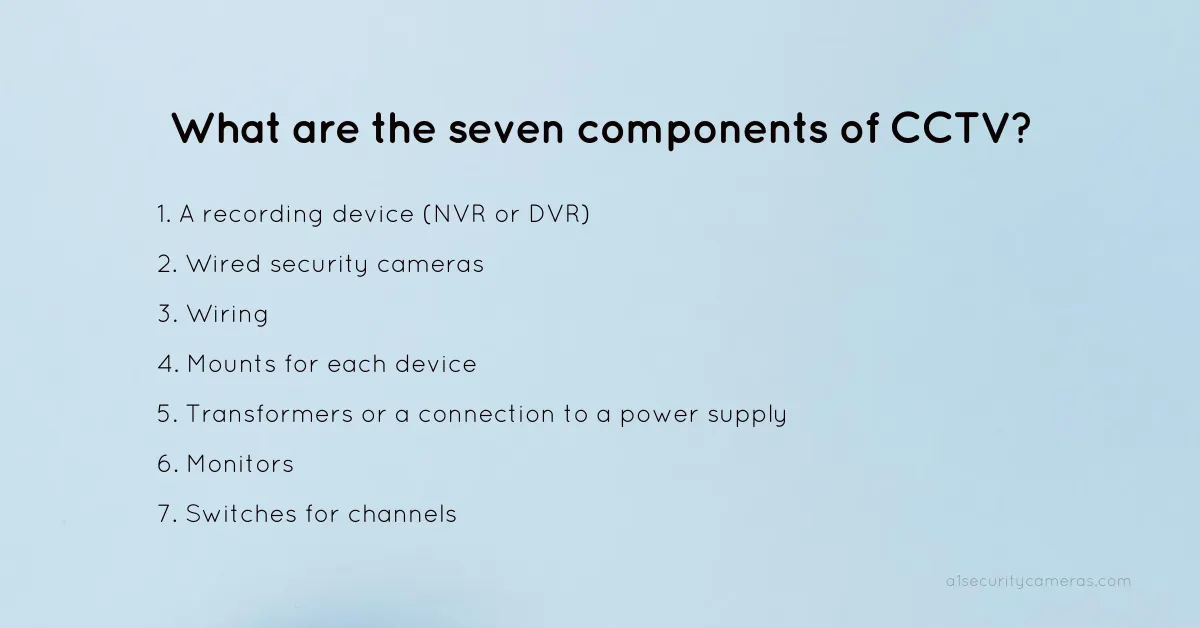
WHAT IS CCTV USED FOR?
CCTV and security camera systems are used for more than deterring crimes, including:
-Hazard or valuable material monitoring
-Perimeter control and security
-The recording of daily events at points of importance
-Residential and commercial insurance
-Traffic monitoring
CCTV is useful for monitoring key locations and deterring crime. Explosion-proof cameras assist monitor hazardous material facilities or storage. Other CCTV cameras give documentation for insurance, legal cases, and more.
Security camera systems, including CCTV, provide homeowners and business owners unique protection. Cameras improve access control, individual safety, and overall security in any site when integrated to a security system. CCTV may be utilized to protect an area over time.
WILL CCTV WORK WITHOUT INTERNET?
Yes, a closed-circuit TV system works without the internet since it’s local. CCTV without internet lacks remote access. It can still monitor, record, and interact with linked systems. Any non-hardwired device won’t work without an internet connection.
WHAT ARE THE ADVANTAGES OF CCTV?
Digital or analog, CCTV’s main benefit is security. While pure access control like turnstiles or recording security systems like DVR and NVR also do so. As demonstrated above, such cameras help house and business owners through:
-Constantly recording areas of importance
-Deterring or scaring off criminal behavior
-Provide crucial information for court proceedings and insurance
-Monitor specified areas or valuable materials
CCTV has several advantages for households and businesses. The solution quickly improves security, local legislation, and internal corporate operations.
Wireless cameras may take up less space and cost less, but they have major flaws. CCTV doesn’t have good performance. Wireless cameras depend significantly on Wi-Fi and reduce streaming, gaming, and other internet activities. As indicated previously, a wired connection is unaffected by internet outage.
ARE IP CAMERAS BETTER THAN CCTV?
IP cameras are the latest generation of security cameras and may be CCTV or wireless. IRoyal Security Cameras says a wired IP camera system is better than a wireless one. A wired system reliably transmits captured video when wireless services fail. While IP cameras are more costly, they will resist future security advances better than CCTV. IRoyal Security Cameras can provide further details about either camera.
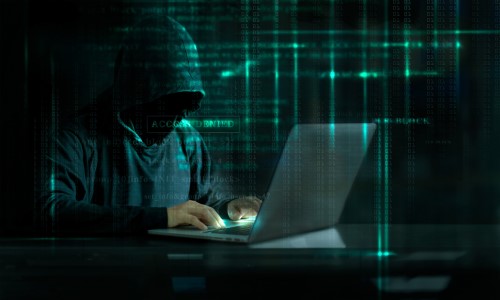
HOW TO KEEP HACKERS FROM BREAKING INTO YOUR SECURITY CAMERAS
It should come as no surprise that hackers and bots are attacking internet-connected gadgets in this day and age. The recorder or cameras must have an internet connection in order for consumers to remotely watch their security cameras. However, this makes security cameras and systems susceptible to conceivable intrusions. Fortunately, there are a lot of steps that businesses and homeowners can take to guard against tampered security cameras.
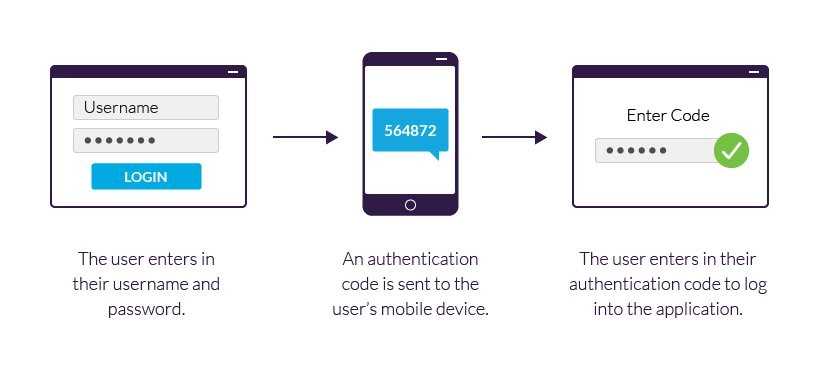
TWO-FACTOR AUTHENTICATION AND PASSWORDS
Because password security is so crucial, students in primary schools are taught about it. The first line of defense for preventing unauthorized access to computers and Internet of Things (IoT) devices is often passwords. We advise creating distinct, secure passwords for each of your devices. A reliable software-based password manager may help keep passwords safe and guard against their being lost or forgotten. Passwords shouldn’t be shared with someone you don’t trust or who may divulge them to others. Password security may be improved by changing them at least every 90 to 6 months.
Don’t forget to use strong passwords to safeguard your email and social media accounts. Often, it is the recovery email account that is taken first and not the password for the security camera or system that triggers a breach. Visit the website Have I Been Pwned to see if your email address or password has already been compromised and is being circulated online.
Two-factor authentication is a second line of defense for password security. In order for a login to be permitted, two-factor authentication uses a different device, often a smartphone or the appropriately titled authenticator app. Two-factor authentication may already be known to you if you log into your bank account online and get a security code through SMS. For an additional layer of protection, enable two-factor authentication on your email and any other device that supports it.

VERIFY ANY UPDATED SOFTWARE AND FIRMWARE
Updates to the software or firmware for your security cameras or security system should always be confirmed with the manufacturer or vendor from where you acquired them. Updates might include patches for serious flaws or hacker-usable exploits. Some gadgets have the ability to scan the internet for updates and download them.
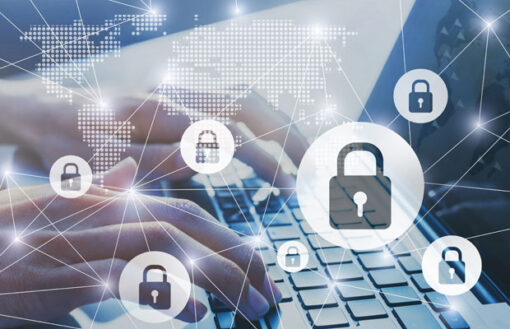
INCREASE NETWORK SECURITY
The gateway for security cameras and recorders is the local computer network and Internet connection. It is simpler for hackers to target cameras and other IoT devices within a network if it has been infiltrated and is readily accessible to hackers.
A smart place to start is by managing your own network with a reliable firewall and having an IT expert examine your network. One of the first things you should do is make sure your router’s firewall is active and put up stringent settings. Denying access to websites from foreign IP addresses is a good general practice. For instance, prohibit IP address ranges coming from nations known for attacking security cameras and systems, such as Russia and China.

BUY FROM A RELIABLE RESOURCES
The issue is comparable to hazardous counterfeit products available on Amazon. Manufacturing efficiency improvements come at the expense of the consumer. Many camera brands are offered at such low rates, but they often lack the necessary research and development to protect them against internet-based assaults.
Software that is poorly developed has oversights that may be used by hackers to exploit common vulnerabilities. Additionally, there are websites that list hacked security cameras from all around the globe. Some websites that are more sinister provide login credentials for cameras that have been compromised or broadcast footage from compromised cameras for public viewing.
Buy from reliable brands like, Hikvision, Dahua, EZviz and TPlink.
MARITIME ( 24/7 Superb images for safety and security in maritime )

Marine CCTV systems are very useful at sea since they provide a live picture from the bridge during maneuvering and berthing and unberthing procedures.
A quick scan of the area around the ship is necessary to assess the risks and complexity of threats like piracy, smuggling, and terrorism before deciding what to do in the event of a threat. The camera streams should be accessible from numerous locations, such as the citadel, in case things get out of hand. They should be able to stream over even the slowest satellite connections. While supporting regular operations, CCTV also provides a wealth of information for incident investigations while the vessel is being loaded or unloaded.
The ecosystem of Hikvision provides solutions based on both contemporary low-latency IP technology and conventional coax wiring. A dependable recording solution and flexible use of multi-site live view are provided by the IP backbone. Any PC can be used to view the video streams, and tablets and smartphones can even be utilized to offer the captain immediate access to the streams from his own cabin.
The ability to see in total darkness is another wonderful benefit of our thermal technology. It can also be used to keep an eye on temperatures to prevent fire, which is a major risk, particularly in maritime environments.
FEATURES
A whole end-to-end solution is available from Hikvision. Since only one manufacturer produces and delivers all components, internal communication between parts will go well because there won’t be any problems with incompatible protocols. A full bundle that guarantees simple operation is the end result.
ARCHITECTURE ANALOG
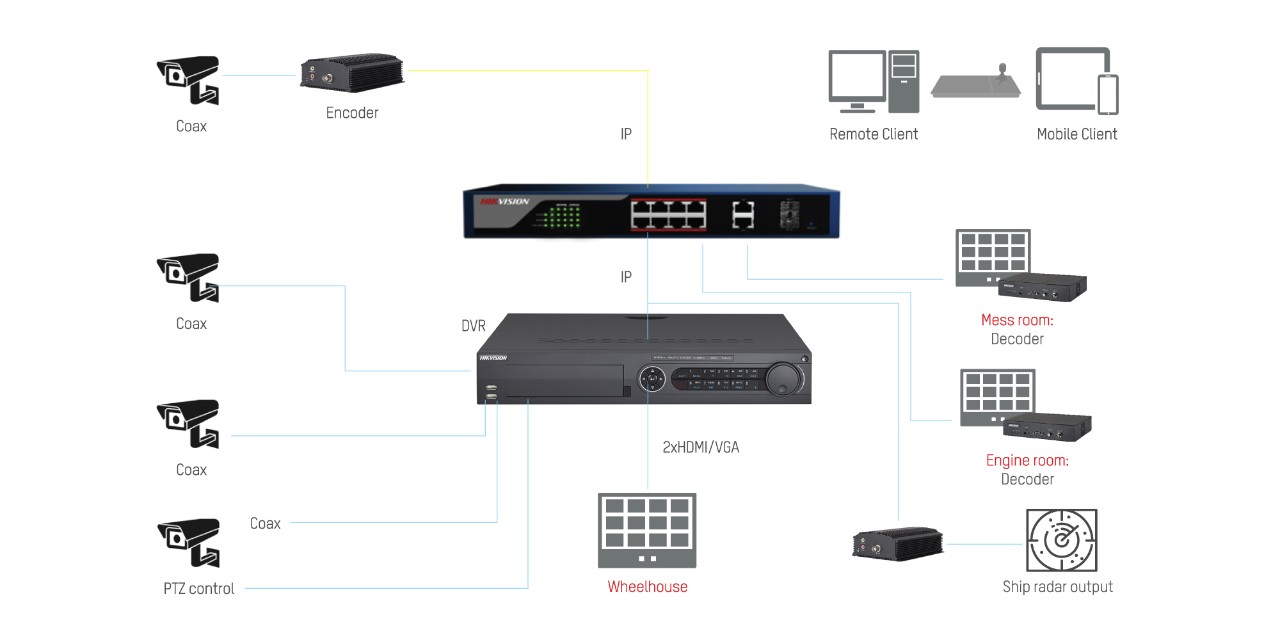
ARCHITECTURE IP
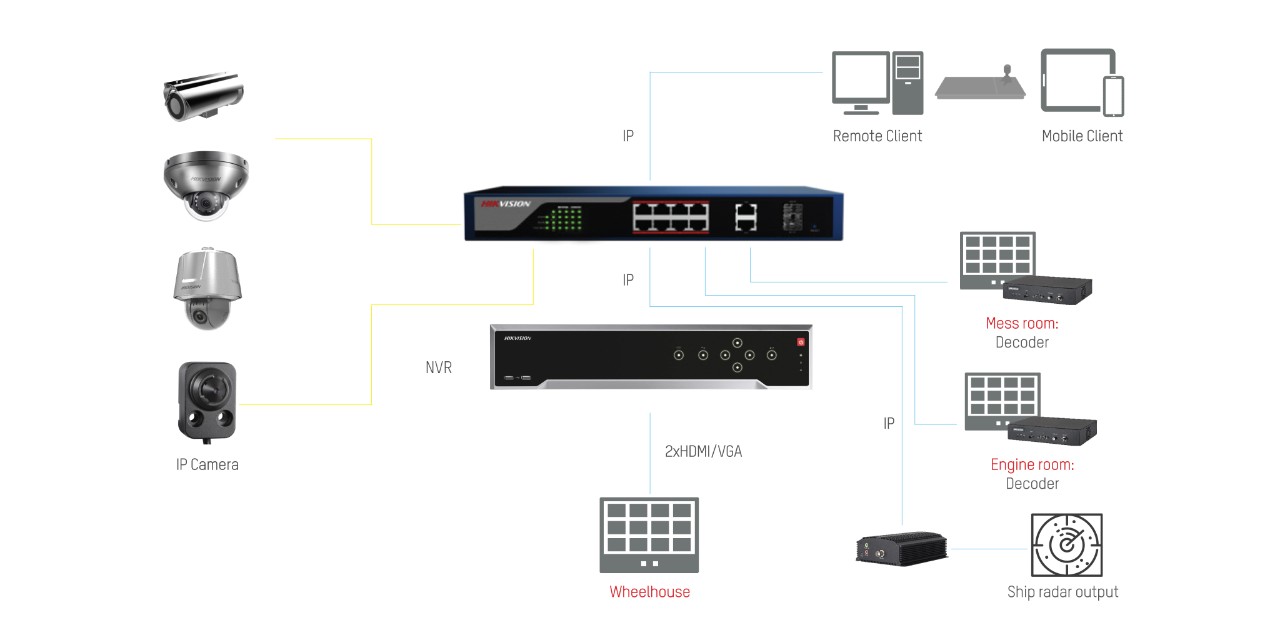
CCTV FOR SHIPS

When it comes to their security requirements, ships are no different from other types of public and commercial spaces in that they frequently use CCTV. Modern CCTV security systems are becoming more and more necessary to enhance on-board security.
It makes sense that maritime applications would be different from on-shore pursuits. It is necessary to be able to see everything that is occurring on board. It can be a challenging environment, so it’s crucial that any equipment used on board is reliable and sturdy in addition to being appropriate for its intended function. Additional assurance will come from keeping an eye on activity across the ship and feeling more in charge at all times.
SHIP SECURITY
There will be security systems for marine vessels of every size, from basic security cameras that display activities in real time from a fixed location to more sophisticated systems that can watch and record from all angles inside the ship. Both during the day and at night, recordings are made, allowing for on-board or ashore viewing as needed.
Just as ships have progressed in recent years, so too have maritime CCTV solutions. These days, cameras are employed to keep an eye on and safeguard personnel, cargo, and equipment. Particularly when it comes to processing any potential claims, their use to record unloading and offloading is important. CCTV is becoming more widely used to help improve safety, ensure efficiency, and ensure the comfort of the entire staff. Even the idea of using the cameras to look outside the ship to provide optimal visibility all around the ship helps with operational needs.
The CCTV security system will be built and developed specifically to work aboard a ship at sea. This specialized video security is not even just for the huge freight ships; it can be utilized for cruise ships, pleasure boats, yachts, or any other marine or inland water vessel. There will be instances that call for a variety of CCTV cameras, including PTZ, dome, analogue, and IP, even though fixed cameras may be more popular. Another fantastic advantage is the capability of using thermal photography for nighttime recording.
BOATS & YACHTS

Yachts and pleasure boats will also require protection due to their high value. Owners will concur that planned travels may be hampered by damage in addition to its monetary value. The boat will be useful, but it will also allow you to engage in a fun activity. With a strong security system, the risk of theft, damage, trespassing, or vandalism can be decreased.
THE USE OF CCTV CAMERAS ON SHIP

In the maritime business, the use of CCTV cameras on ships is crucial. It offers security and safety for those on board ships and can be used to monitor the navigation, engine room, cargo operations, berthing and unberthing, and many other aspects of the ship. The footage from recorded maritime incidents can support the appropriate authorities during their investigation.
CCTV CAMERAS PROVIDES PROTECTION FOR HUMANS AND PROPERTY
CCTV MUST MEET CERTAIN CRITERIA
CCTV cameras must adhere to various requirements, some of which include:
– CCTV cameras must meet certified and recognized marine standards.
– Requirements for camera maintenance
– The ability to sync camera clocks with other systems’ clocks.
– Considerations for cyber security if CCTV footage can be downloaded or accessed remotely
– Data protection concerns
– Local laws applicable to the vessel’s trading region, and only when permitted
– Data recording and storage
HOW TO CHOOSE THE RIGHT SECURITY CAMERAS FOR YOUR HOME

Security cameras can be an effective tool for keeping your home and property secure while you’re away.
Because every home is different, it’s important to choose the best security cameras to suit your family’s requirements. There is a perfect security camera for any location in and around your home that requires monitoring, offering a variety of designs and power options in addition to a wide range of practical features.
STEP 1: DETERMINING HOW MANY HOME SECURITY CAMERAS I NEED AND WHERE TO INSTALL THEM

To determine how many cameras you need for complete coverage, you first need to consider the size and layout of your home and land. The more entrance points or concealed corners there are, the more you might want to keep an eye on them. The following is a list of the most typical uses for security cameras:
– Access points such as front doors, locations close to first-floor windows, and garages
– Your property’s potential blind spots, such as a basement entrance or any shadowy nooks.
– Sheds, barns, or backyards.
– Your driveway, particularly if you park your vehicles there.
– Places in your home that your pets can access or other areas you wish to watch over while you are away or in another room.
You may count the number of security cameras you need and choose where to put them based on how many of these areas you have in your home. Consider your neighbors’ privacy as well as local regulations and ordinances when deciding where to place your security cameras.
STEP 2: WHAT KIND OF HOME SECURITY CAMERA DO I NEED FOR EACH LOCATION?

The next step is to take a closer look at each location to identify power sources and mounting alternatives once you know where you need to install security cameras. Here are some things to think about:
Mounting options: Some cameras come with stands so you can just set them down on a flat surface, but other cameras require mounting. Before you begin drilling, make sure you adhere to the rules established by your HOA or landlord, as appropriate.
Power Sources: Security cameras can be powered in a variety of ways, including hardwiring to a junction box, plugging directly into the grid, and even receiving power over Ethernet. In order to get started, be sure that each location has one of those sources. Additionally, you have the option of going wireless, but bear in mind that you’ll require access to change the battery. Additionally, there are designs where the battery is charged by a solar panel. You don’t need to swap out the batteries for this, but you will need to set the solar panel so it receives enough direct sunlight.
Access to the internet: Ensure that each location has a reliable WiFi signal. Otherwise, you might need to get some WiFi boosters. Alternately, if you have access to ethernet in some locations, you can select a camera that supports power over Ethernet (PoE).
Additional features: Consider what other features you could require in each location. You could need night vision if your property has any exceptionally gloomy sections. A camera with motion-activated LED lights will be an excellent choice if you could use a little extra illumination over a driveway or a sidewalk. A siren can be a useful component for added security.
WHAT ARE THE DIFFERENCES AMONG CCTV DOME, BULLET AND TURRET CAMERAS?
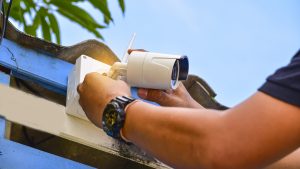
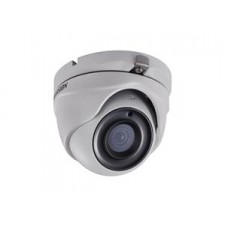
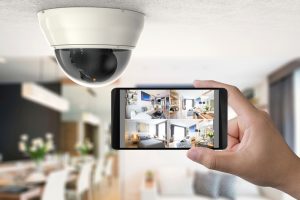
Although CCTV systems have long been used in professional settings, more and more people are installing them on their personal properties. It makes perfect sense because it is an easy way to secure your property and is generally trouble-free once installed. But are you aware of the numerous kinds of cameras you may install in your house? Here is a glossary to help you understand some of the phrases you may run across when looking at CCTV cameras.
- Bullet cameras
- Turret cameras
These smaller cameras are more covert and frequently utilized in home settings. They are quite similar to dome cameras but do not have the plastic cover. However, they can be installed in the majority of parts of the property and are still noticeable to those who are searching (internally and externally). Now available in white and dark gray, they can better match the building. They offer a wide range of characteristics, which are shown below, and are available with fixed and changeable lenses.
- Pan, tilt and zoom
- Vandal proof / Dome cameras
- Wide angle
- Infrared
- Colour vision camera
- Variable zoom
- Fixed lens
- Thermal imaging
Due to its capacity to observe thermal variations and produce a thermal map, this kind of camera is now much more prevalent in business settings. It is more frequently used in commercial settings than in homes.
- HD / 4K Cameras
Manufacturers are now able to build cameras of much higher quality than ever before at a considerably lower cost because of improvements made to the chips inside them. When paired with other features like motion sensors, facial recognition, and thermal imaging, it makes identification simpler and increases the likelihood that the image will be useful in the event of an incident.
IMPORTANCE OF CCTV CAMERAS IN SCHOOLS
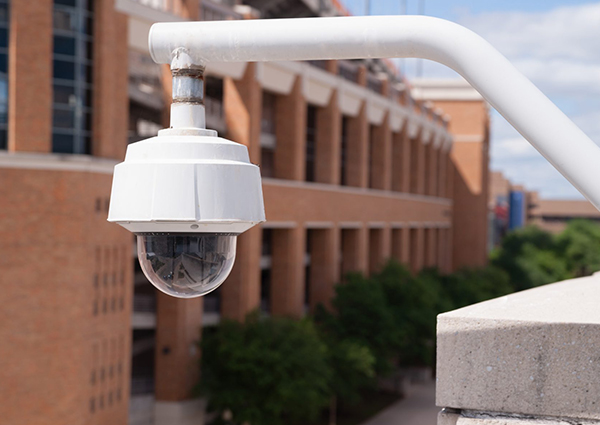
In this post, you will discover the significance of CCTV cameras in schools. Every parent and responsible citizen has questions and reservations as a result of the rising instances of carelessness and crimes that violate children’s innocence. Making sure our kids are protected and feel safe at all times is urgently needed.
We can all strengthen ourselves in this struggle by being vigilant and on the lookout for any abnormalities or deviations in children’s behavior. However, because we are just humans, we occasionally overlook details or let our guard down. How can we then ensure that kids are safe?
1. Monitoring the activities
Anyone with malicious intentions encounters it as a barrier. It assists in keeping track of and monitoring the activities occurring on school property. It helps to identify and apprehend any offenders or intruders. It enables the maintenance of efficient access control so that only authorized individuals can access the school, making it simpler to maintain the security of a school’s exits and entrances. Because it is inhuman, it supplements the security guards and thus never loses focus or tires. It assists in monitoring assets and ensuring proper use of resources inside the school.
2. Lowering the reaction time
When preparing for security exercises and coordinating evacuation in case of crises, it helps shorten reaction times. In the event of theft or damage, it is a helpful tool for locating offenders and defending the school’s property.
3. Attendance of every employee
It can be used to monitor the attendance of teachers, students, and support staff, as well as to ensure that everyone is working effectively and efficiently. With an increase in bullying and raging incidents, it not only serves as a deterrent but also helps in bringing those responsible to justice. It also helps to ease parents’ concerns about their children’s security and safety while they are away at school.
4. Guide the Students
The instructors’ punctuality and instructional strategies might be monitored by the authorities. Guidance for pupils is crucial. The course gets very stressful and busy without any teacher assistance. By monitoring instructors’ performance, CCTVs can ensure that the next generation is being educated effectively.
5. Prevents any Malpractices
It assists in preventing any malpractices. The properties are protected when children don’t copy assignments and tests. Since CCTV monitors the area, instructors or other personnel cannot be bought off. It helps monitor the campus constantly and can help avoid tampering with official paperwork and exam papers.
Every action that takes place on a school campus that has an integrated security system installed, regardless of when it occurs, is recorded, and every corner is monitored. The campus’s CCTV cameras also serve as the school’s administrators’ ears and eyes.


